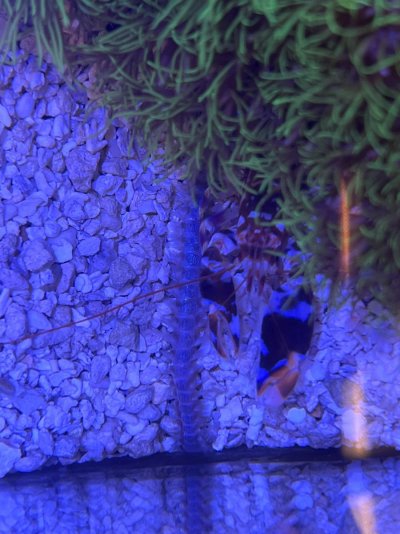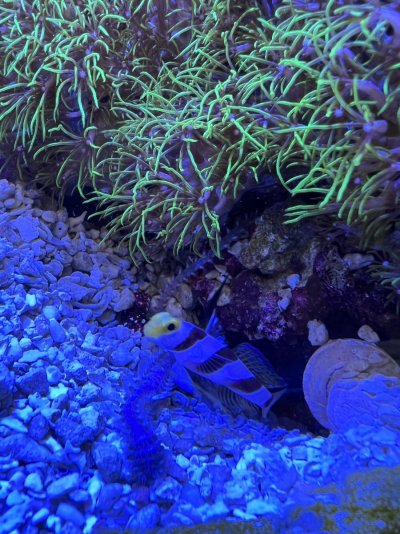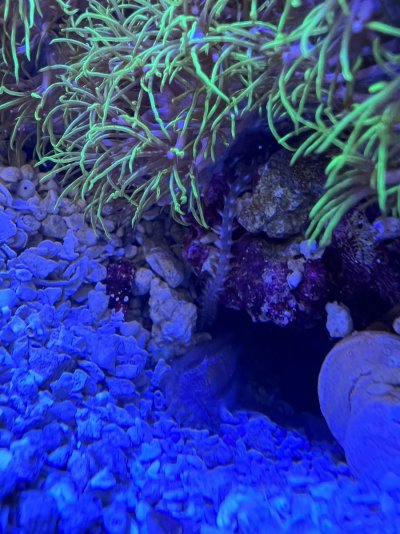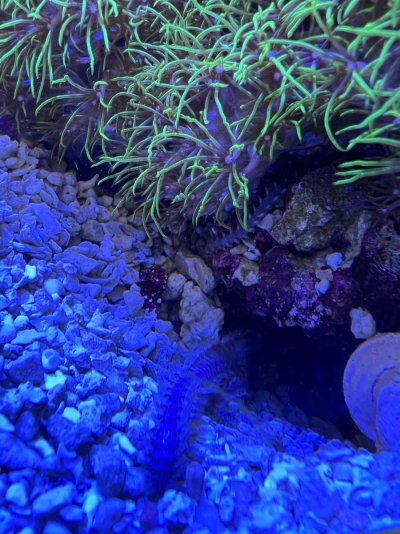Navigation
Install the app
How to install the app on iOS
Follow along with the video below to see how to install our site as a web app on your home screen.

Note: This feature currently requires accessing the site using the built-in Safari browser.
More options
You are using an out of date browser. It may not display this or other websites correctly.
You should upgrade or use an alternative browser.
You should upgrade or use an alternative browser.
Is this a Fireworm or just a massive bristle worm?
- Thread starter Brit’s Fish
- Start date
- Joined
- May 14, 2018
- Messages
- 2,395
- Reaction score
- 2,707
- Review score
- +0 /0 /-0
- Location
- in front of my computer
Fire, I believe
I’m thinking the same but I was hoping someone would just come along and say, “oh, that’s just a regular bristle worm” so that I don’t have to go nuclear on this tank. Thanks for confirming my fears though!Fire, I believe
- Joined
- May 14, 2018
- Messages
- 2,395
- Reaction score
- 2,707
- Review score
- +0 /0 /-0
- Location
- in front of my computer
Try a trap before you go nuclear.I’m thinking the same but I was hoping someone would just come along and say, “oh, that’s just a regular bristle worm” so that I don’t have to go nuclear on this tank. Thanks for confirming my fears though!
aSaltyKlown
Active Member
- Review score
- +0 /0 /-0
R2R Secret Santa 2022
Build Thread Contributor
This make me feel a lot better. As I said, I was hoping someone would tell me this. These two big guys I’ve seen in that tank are about the width of my pinkie finger and darker than the smaller ones with a sort of iridescence to their skin. However, if I touch them with tongs, they go right back into the rocks. I haven’t ever seen them bother anybody - my goby and pistol pair and my Helfrichi pair live in the same rock that guy is in.
Sorry to ve a kill joy. That worm in the first post is a fire worm.This make me feel a lot better. As I said, I was hoping someone would tell me this. These two big guys I’ve seen in that tank are about the width of my pinkie finger and darker than the smaller ones with a sort of iridescence to their skin. However, if I touch them with tongs, they go right back into the rocks. I haven’t ever seen them bother anybody - my goby and pistol pair and my Helfrichi pair live in the same rock that guy is in.
Those red tuffs are a dead give away. However, I don't believe it's the dreaded bearded fire worm. But, perhaps a Caribbean fireworm.
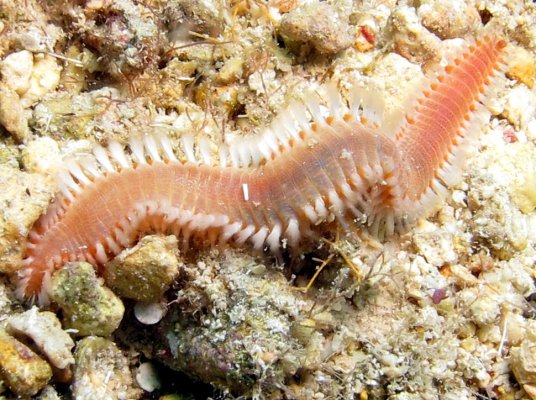
There are 10-20 in your tank , and will continue to multiply regardless of what you do.
I find them part of clean up crew. They may be responsible for a lot of fish missing
I used to at midnight use a flashflight and tweezers to reduce the numbers in my tank. It seemed helpful
I find them part of clean up crew. They may be responsible for a lot of fish missing
I used to at midnight use a flashflight and tweezers to reduce the numbers in my tank. It seemed helpful
EeyoreIsMySpiritAnimal
Just another girl who likes fish
- Review score
- +0 /0 /-0
Partner Member 2023
Build Thread Contributor
- Joined
- May 14, 2019
- Messages
- 7,940
- Reaction score
- 11,218
- Review score
- +0 /0 /-0
- Location
- Spring, Texas
I see zero red tufts here. I do see pinkish flesh between the white bristles.Sorry to ve a kill joy. That worm in the first post is a fire worm.
Those red tuffs are a dead give away. However, I don't believe it's the dreaded bearded fire worm. But, perhaps a Caribbean fireworm.
View attachment 3118280
http://www.ronshimek.com/annelids.htmlSorry to ve a kill joy. That worm in the first post is a fire worm.
Those red tuffs are a dead give away. However, I don't believe it's the dreaded bearded fire worm. But, perhaps a Caribbean fireworm.
View attachment 3118280
i think you’re right, but luckily from what I’ve read about that Caribbean fireworm (aka Eurythoe complanata) they appear to eat deteitus. I have a couple in my tank that live in a hole and come out when I feed heavy or stir up a dead spot with the powerhead.
I have 1 or 2 left. I love the Caribbean orange fire worms. But the size they get may terrify people.http://www.ronshimek.com/annelids.html
i think you’re right, but luckily from what I’ve read about that Caribbean fireworm (aka Eurythoe complanata) they appear to eat deteitus. I have a couple in my tank that live in a hole and come out when I feed heavy or stir up a dead spot with the powerhead.
EeyoreIsMySpiritAnimal
Just another girl who likes fish
- Review score
- +0 /0 /-0
Partner Member 2023
Build Thread Contributor
- Joined
- May 14, 2019
- Messages
- 7,940
- Reaction score
- 11,218
- Review score
- +0 /0 /-0
- Location
- Spring, Texas
I believe that many (myself included) have incorrectly assumed that all "FIREworms" are bad; but as the excellent article from Ron Shimek (posted by @TinyReefObsession above) explains, the fireworms commonly found in our tanks are harmless detritus worms and are as beneficial to the system as "regular" bristleworms. In fact, "regular bristleworms" is probably an incorrect term since there does not seem to be a consensus on the difference between a fireworm and bristleworm (especially given that the "fire" most hobbyists fear is being injured by the bristles, and all bristleworms can cause pain and irritation if handled bare-handed).http://www.ronshimek.com/annelids.html
i think you’re right, but luckily from what I’ve read about that Caribbean fireworm (aka Eurythoe complanata) they appear to eat deteitus. I have a couple in my tank that live in a hole and come out when I feed heavy or stir up a dead spot with the powerhead.
Carnivorous (i.e. undesirable) fireworms seem clearly different in appearance as well as in behavior, and are extremely likely NOT to be the worms we see at night and/or coming out from under the rocks right after we feed.
Looks like a standard bristle worm to me. Not really anything to be concerned about. I used to hunt them down and take them out anytime I found them. But there were always more. I gave up. Good cuc imo.
Same!!! Lol i’m not going to lie- once I was sure I had identified a fireworm in my tank I was losing sleep haha but now I have a note with a handful of saved articles, all mentioning that this particular one(any many others) eat detritus- basically to remind me not to flip outI believe that many (myself included) have incorrectly assumed that all "FIREworms" are bad; but as the excellent article from Ron Shimek (posted by @TinyReefObsession above) explains, the fireworms commonly found in our tanks are harmless detritus worms and are as beneficial to the system as "regular" bristleworms. In fact, "regular bristleworms" is probably an incorrect term since there does not seem to be a consensus on the difference between a fireworm and bristleworm (especially given that the "fire" most hobbyists fear is being injured by the bristles, and all bristleworms can cause pain and irritation if handled bare-handed).
Carnivorous (i.e. undesirable) fireworms seem clearly different in appearance as well as in behavior, and are extremely likely NOT to be the worms we see at night and/or coming out from under the rocks right after we feed.
- Joined
- Aug 29, 2020
- Messages
- 3,484
- Reaction score
- 3,492
- Review score
- +0 /0 /-0
- Location
- Central Texas
Doesn't look like a bearded fireworm, which has fairly prominent red tufts and tends to be fairly chunky. That's the coral-eating species. Also doesn't look like a regular bristleworm, though white light would be helpful there.
Similar threads
- Replies
- 4
- Views
- 161


